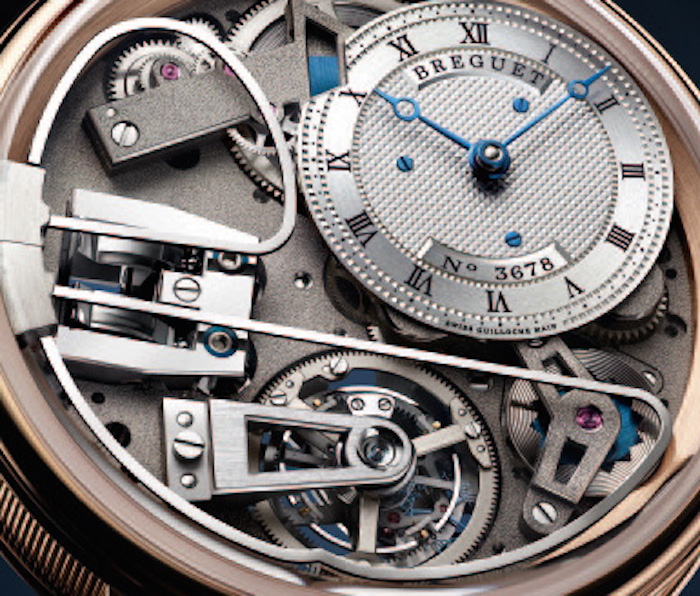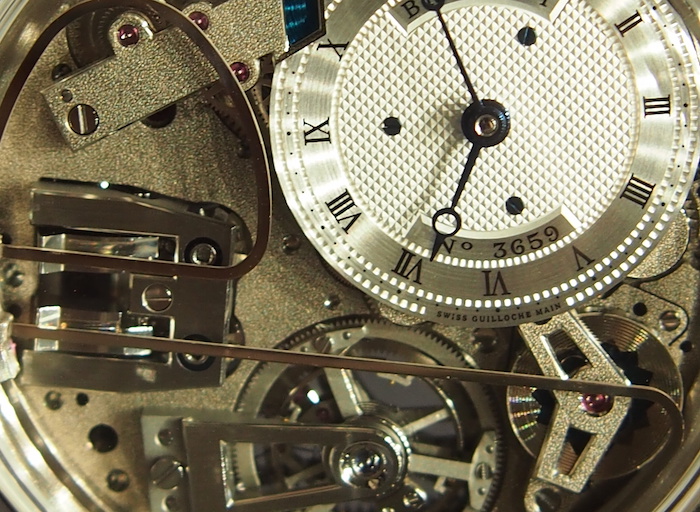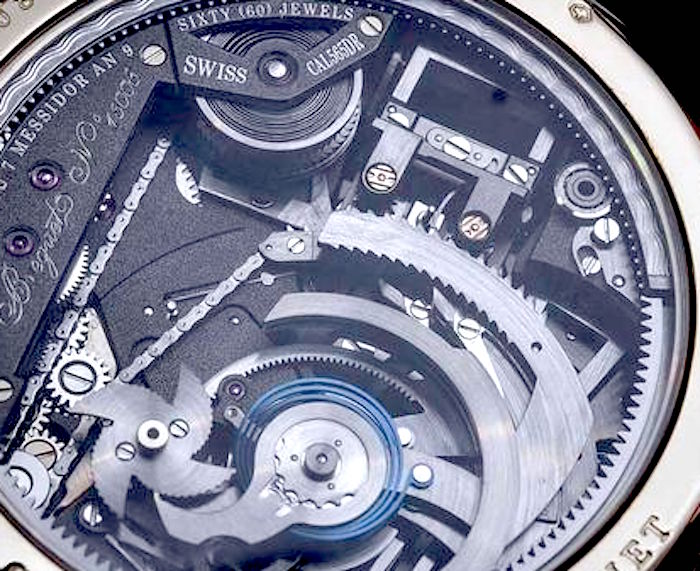By Gordon Henderson
Breguet as a brand has, since it’s founding, been at the forefront of horological innovations. The company is able to claim a number of game-changing firsts: the first self-winding movement, the first striking repeating watch operated by gong spring rather than a bell, and the first Tourbillon (among others). As such, the brand regularly has something special to celebrate. This year it is the 10th anniversary of its Tradition line — a collection based on the brand’s rich heritage in powerful watchmaking but with a visionary twist.
To celebrate, Breguet brings its expertise to the next level in the Breguet Tradition Repetition Minutes Tourbillon 7087– which is hitting stores around the world now. In designing the 7087, Breguet sought to take full advantage of today’s technology to help enhance the features they helped pioneer centuries ago — and they did so from the ground up.
 As the piece is a minute repeater, the first consideration the manufacturer took note of was the desired sound they wanted to create for the chimed the hours, quarter hours and minutes. To do that engineers, using synthesized sounds, listened to approximately one hundred thousand sounds which were then classified into different categories based on psychoacoustic criteria. The sounds were then listened to again and evaluated to identify the two specific tones the final product would produce. The timepiece was then built to produce the same tones the engineers identified in the preproduction phase. This process would come to dictate every piece of material used, as well as how the mechanics of the repeater would be developed.
As the piece is a minute repeater, the first consideration the manufacturer took note of was the desired sound they wanted to create for the chimed the hours, quarter hours and minutes. To do that engineers, using synthesized sounds, listened to approximately one hundred thousand sounds which were then classified into different categories based on psychoacoustic criteria. The sounds were then listened to again and evaluated to identify the two specific tones the final product would produce. The timepiece was then built to produce the same tones the engineers identified in the preproduction phase. This process would come to dictate every piece of material used, as well as how the mechanics of the repeater would be developed.
Naturally, the brand recalled the gong springs invented by Abraham-Louis Breguet in 1783, which were originally coiled and mounted to the backplate. Those have now been entirely reworked to suit the acoustic requirements set by the engineers. The gongs are now attached to the bezel to help the transmission of the vibrations created by the striking mechanisms. Additionally a radiating bezel screwed to the case band with three pillars allows the bezel and glass to vibrate freely. This innovation results in improved sound emission at low frequencies.
In terms of how the gongs strike and make contact, Breguet has also taken a unique approach. Unlike other minute repeaters where the hammers travel horizontally to the movement, the 7087’s hammers strike vertically from the movement towards he bezel. Again, the change here is to allow for added efficiency in the creation of sound. Breguet has also employed a semi active buffer that maximizes the hammer’s striking power while minimizing the effects of its reverberation. If not handled properly the reverberation could lead to a double strike thereby disrupting the continuity of the tones played while the repeater is activated. To achieve this an articulated damper is synchronized with the strike of the hammer and is immediately pulled back by a spring. To help carry the sound an 18k gold membrane is fixed to the bezel and sapphire case back. The purpose is two fold as 1) the membrane helps to amplify the sound and 2) it allows for an unobstructed view of the movement.
 Breguet’s obsession with getting the sound just right on the piece extends from the elements described in its construction to the materials used. The baseplate and bridges of the Tourbillon are done in titanium, while difficult to work with, was selected specifically for its ability to transmit sound. In terms of the case itself, there are two metal options, either white or rose gold case with matching gong. The reason the gongs match is more than visual aesthetics. Having matching metals also allows for sound to carry better from the gongs and through to our ears. Additionally, the 7087 makes use of the magnetic governor found in the Classique La Musicale. A patented system of silver weights pass underneath magnets which help control the speed of the striking mechanisms. An adjustment spring is used to regulate how close the weights are to the magnets and thereby regulates the speed and tempo of the piece.
Breguet’s obsession with getting the sound just right on the piece extends from the elements described in its construction to the materials used. The baseplate and bridges of the Tourbillon are done in titanium, while difficult to work with, was selected specifically for its ability to transmit sound. In terms of the case itself, there are two metal options, either white or rose gold case with matching gong. The reason the gongs match is more than visual aesthetics. Having matching metals also allows for sound to carry better from the gongs and through to our ears. Additionally, the 7087 makes use of the magnetic governor found in the Classique La Musicale. A patented system of silver weights pass underneath magnets which help control the speed of the striking mechanisms. An adjustment spring is used to regulate how close the weights are to the magnets and thereby regulates the speed and tempo of the piece.
In a nod to the past and the pocket repeaters prevalent during the lifetime of the brand’s namesake, a bayonet pusher has been selected to engage the repeater. To begin the chimes, the pusher needs to be slightly unscrewed and then simply pressed. Furthermore, the 60 second Tourbillon was selected to be added to the piece as an acknowledgment of Louis Breguet’s lasting legacy to the world of horology. This Tourbillon, unlike the one produced centuries ago, features an antimagnetic silicon spring and escapement.
This piece is a stunning example of cutting edge technology being used to enhance fine hand craftsmanship. From concept to design, Breguet has created a piece that is both modern and historically significant. The case is 44mm, features an off center dial with Roman numeral hour indices and open tipped blued steel hands. The fact that the dial is off center allows the mechanical elements of the piece to be on full display as the movement if viewable on both sides of the case. The dial is engine turned by hand, the case is fluted and features welded lugs. The piece sports an 80 hour power reserve with indicator at the aperture at the 12 o’clock. It will retail for $460,700.







